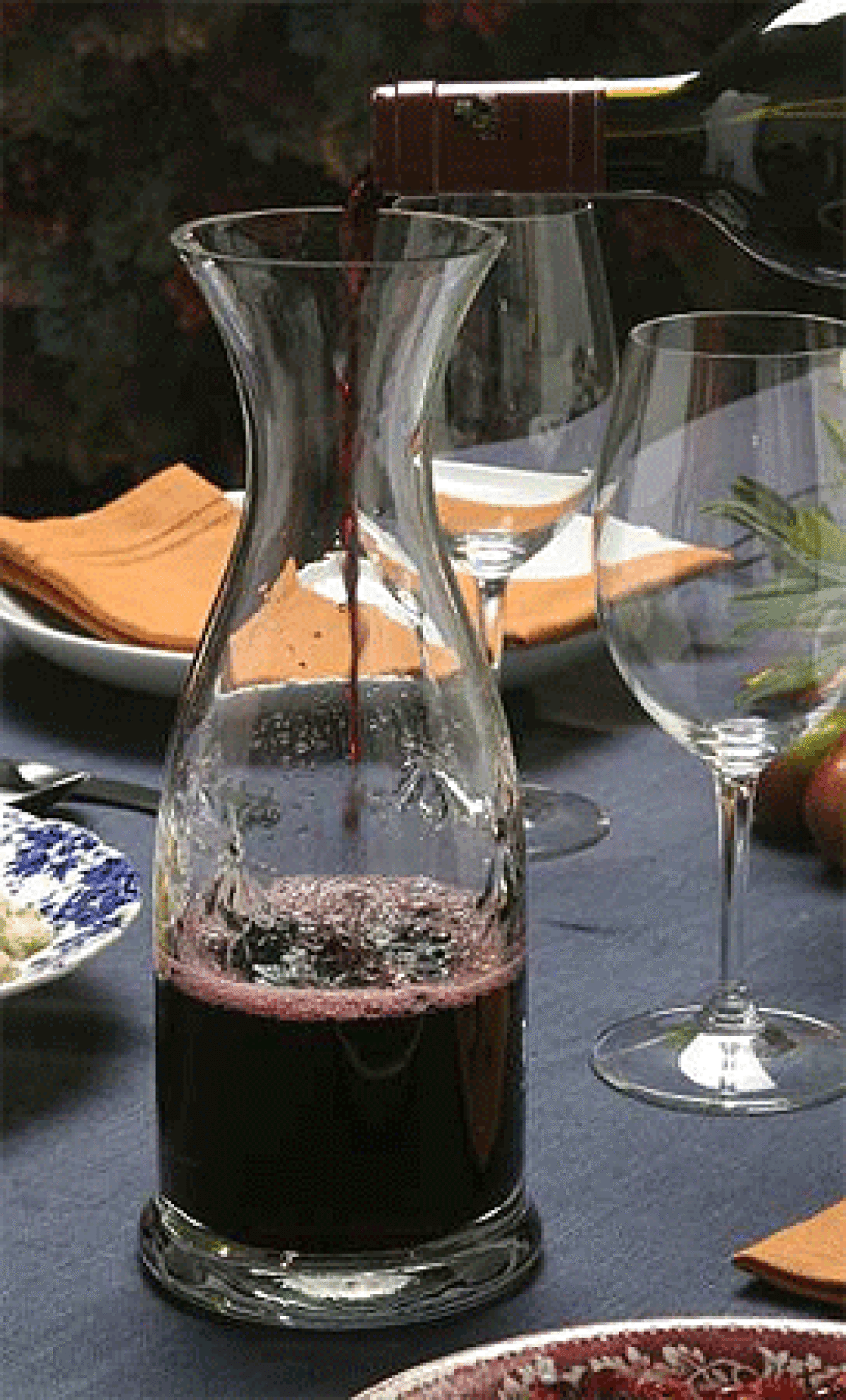Let that wine genie out of the bottle

YOUâVE wandered the aisles of wine shops, imagining what would really delight your guests; youâve sought out the most delicious possibilities your budget will allow. But there is still one more thing you can do that will almost invariably enhance whatever wine you have decided to serve at Thanksgiving dinner: Decant it.
If you thought decanting was a ritual reserved for venerable bottles of Bordeaux or expensive Cabernet Sauvignons from the Napa Valley, youâre wrong. The simple act of pouring it out of the bottle and into a glass container for serving can flesh out almost any wine. Less expensive, younger wines may actually benefit the most.
Decanting exposes wine to air â oxygenating the wine â which produces a chemical reaction that releases aromas and flavors, says Bonnie Graves, a former Spago sommelier who now teaches wait staffs proper wine service. Young wines, with tight, closed structures, unwind after oxygenation. âDecanting opens them up, helps to free the esters and allows the aromas to develop,â says Graves.
Red wines benefit the most, but Graves believes that white wines can improve with decanting as well. âA huge California Chardonnay can even out and calm down after decanting,â says Graves. âBesides, decanting never hurts a white wine.â
Given the benefits, itâs surprising how rarely Los Angeles sommeliers suggest decanting younger wines. But decanting is not just a special-occasion ritual. Once you get the hang of it, itâs simple enough to make part of your everyday wine service at home.
Decanting doesnât require any special skills. Although it might be tempting to pour the wine vigorously into a decanter, really sloshing it around as if the bubbles and froth are evidence that more oxygen molecules are infusing the wine, forget it, says Sona sommelier Mark Mendoza. A gentle pour is just as effective.
Most people associate decanting with the arcane-looking ritual to separate the grit and sediment out from older wines. But if youâre serving a more expensive wine, even if itâs still on the young side, thereâs a good chance it will be âunfined and unfiltered,â which means there may be sediment. This goes for both reds and whites.
âAny wine that hasnât had the life cleaned out of it is going to have sediment,â says Graves. âAnd tannic wines such as Cabernet Sauvignon, Bordeaux and Nebbiolo can throw sediment at any time.â So youâll always want to decant these wines.
Decanting separates âthe good juice from the crappy stuff,â says Graves. âYou pour off as much of the good wine as you can into the decanter, leaving the sediment behind in the wine bottle.â
*
The sediment question
HOW exactly do you do that? Itâs a bit different than decanting wine just to oxygenate it. If your goal in decanting is to eliminate sediment, says Mendoza, then stand the bottle upright for at least a day to allow the sediment to settle on the bottom. Then, as you slowly pour the wine into the decanter, shine a penlight through the wine as it moves down the bottleâs neck. If you see any sediment escaping into the decanter before youâre close to the end of the bottle, slow down, he says. Youâre pouring too fast.When the bottle is almost empty, slow down even more. Then, when you see sediment in the neck, stop. Youâre finished.
If the wine youâve decanted is young, you can then oxygenate it by decanting again. And again. Mendoza gently pours the wine back and forth between two decanters to expose it to more oxygen. Itâs the same drill for reds and whites. âWith young white Burgundies, thereâs a lot of sulfur on these wines,â he says. Decanting in this way helps to blow it off. Does that mean buying two expensive decanters? Certainly not. At home, Mendoza uses a glass flower vase. A glass water pitcher works just as well, he says. The important thing is to use an inert material, such as glass or crystal, that doesnât interact with the wine. Clear decanters have the advantage of showing off the color, an important part of enjoying wine.
âI donât like the frilly decanters. Theyâre a pain to clean,â he says. At Sona, however, it might look odd to pour wine from a vase. There he uses a simple upright Riedel decanter. Wide-based decanters, sometimes in whimsical shapes like headless swans or long-necked geese, expose a greater surface area of wine to the air, which allows gentle oxidation. That slight advantage, however, is outweighed by the greater difficulty of cleaning, says Mendoza.
When do you decant the wine? With most everyday bottlings, you can decant just before serving. For extremely tannic red wines, including Barolo, Barbaresco, Bordeaux and Châteaneuf-du-Pape, Mendoza suggests decanting a couple of hours before dinner is to be served. Those wines may take longer to open up.
*
When to think twice
THERE is an exception to the decanting rule, according to both Graves and Mendoza. With delicate older wines such as Burgundies, oxygen can steal the flavors rather than enhance them. âYou run the risk of losing the wine. It can break down, and the charming characteristics are gone,â says Mendoza.âIâll put up with a little sediment in the bottom of my glass before I decant any fragile, old Burgundy,â notes Graves. It just requires slow, watchful sipping and leaving a bit of wine behind in the glass.
Graves keeps a square of cheesecloth handy. If you make the mistake of piercing the bottom of the cork with the corkscrew, bits of cork may break off into the bottle. And then there are those older bottles that have disintegrated corks. To avoid serving wine with bits of cork floating in it, Graves covers the bottle mouth with cheesecloth as she decants.
Of course, decanting any wine can be a disaster if the decanter isnât squeaky clean. Mendozaâs trick? Fill the decanter with water and drop in an Efferdent tablet, then rinse with plain water after the bubbles have subsided.
Graves prefers old-fashioned steaming hot water. âClean means no soap residue. Thatâs a problem because washing them with soap always leaves a residue,â she says. Even a run through the dishwasher leaves a detergent smell and taste that can be tough to vanquish.
With your â very clean â decanter in hand, this yearâs Thanksgiving wines are going to be the best youâve ever served.
*
(BEGIN TEXT OF INFOBOX)
Knowing how and when to pour
The wine is decanted, the turkeyâs carved and your familyâs around the table. Now all thatâs left is to pour the wine. We all know how to pour a glass of wine, donât we?
Or do we?
Wine service at home is different than in restaurants, which typically pour 6-ounce glasses. But enjoying wine to its fullest means being able to swirl it in the glass, releasing even more aromas â and a 6-ounce pour doesnât leave enough room to swirl without the wine ending up on the tablecloth.
Instead, pour just 3 or 4 ounces of wine in each glass, leaving plenty of room for swirling. Itâs the job of the host to make sure everyoneâs glasses are filled.
The correct temperature for serving wine? Sona sommelier Mark Mendoza likes to serve red wines at 65 to 68 degrees. To bring them down a few degrees from room temperature, just put them in the fridge for 20 minutes. Mendoza likes white wines to be a touch cooler, which means keeping them in the fridge until you are putting the finishing touches on the meal. Just pull them out 10 to 15 minutes before serving.
Bonnie Graves, a wine educator and former Spago sommelier, is less traditional. âI like my white wines warmer than most Americans. Wines with complexity and layers, served too cold, you canât taste anything,â she says. âI prefer to serve whites just a few degrees below room temperature.â
With less expensive white wines, however, the cold is a good disguise. It can mask inadequacies.
â Corie Brown
More to Read
Eat your way across L.A.
Get our weekly Tasting Notes newsletter for reviews, news and more.
You may occasionally receive promotional content from the Los Angeles Times.










